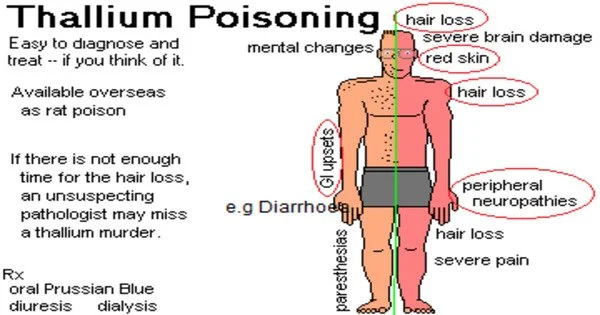Thallium is a heavy metal that has the potential to be extremely hazardous to humans. Thallium poisoning is caused by thallium and its derivatives, which are frequently exceedingly hazardous. It is primarily transmitted through eating, although it can also be transmitted through inhalation or skin contact. Skin contact is hazardous, and proper ventilation should be maintained when melting this metal.
Thallium was once employed in rodent poisons and insecticides, but its usage has been restricted in many countries due to its toxicity. Many thallium compounds are very water soluble and easily absorbed through the skin. They should not be exposed to more than 0.1 mg per m2 of skin in an 8-hour time-weighted average (40-hour work week).
Part of the rationale for thallium’s severe toxicity is that when it is present in aqueous solution as the univalent thallium(I) ion (Tl+), it resembles important alkali metal cations, particularly potassium (due to comparable ionic radii). As a result, it can enter the body via potassium uptake pathways.
Other elements of thallium’s chemistry, such as its affinity for sulfur ligands, set it apart from the alkali metals. As a result, this alteration disturbs several biological functions by interfering with the function of proteins that contain cysteine, a sulfur-containing amino acid. Thallium was initially employed as rat poison, however it was phased out due to the risk of exposure.
Symptoms of thallium poisoning can vary depending on the amount and duration of exposure, but they often include:
- Gastrointestinal issues: Nausea, vomiting, abdominal pain, and diarrhea are common symptoms.
- Neurological symptoms: Thallium can affect the nervous system, leading to symptoms such as headaches, confusion, seizures, and in severe cases, coma.
- Hair loss: One distinctive symptom of thallium poisoning is hair loss, which often occurs 1-2 weeks after exposure. The hair loss can be temporary or permanent.
- Skin changes: Skin rashes and discoloration may occur.
- Renal dysfunction: Thallium can affect the kidneys, leading to kidney damage.
If you suspect thallium poisoning, you should seek medical assistance right away. Blood and urine tests to assess thallium levels are frequently used in the diagnosis. Supportive care, such as the administration of Prussian blue or other chelating agents, may be used to help the body eliminate thallium. Hospitalization and significant medical intervention may be required in extreme situations.
Thallium poisoning is uncommon, and the use of thallium in consumer items is prohibited in many countries. Nonetheless, it is critical to be aware of potential sources of thallium exposure and to take the necessary precautions to avoid unintentional poisoning. Contact your local poison control center or seek immediate medical assistance if you fear you have been exposed.
















